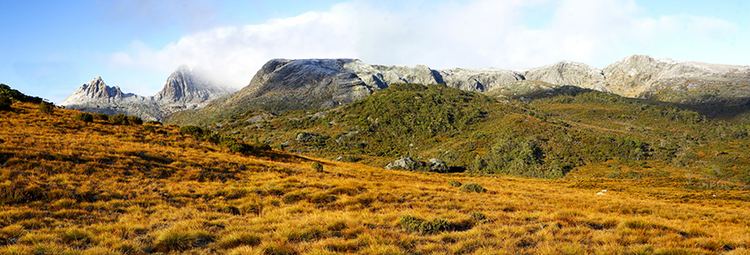Use Hiking Length 65,000 m | Trail difficulty Medium | |
 | ||
Highest point Alpine plateau between Marions Lookout and Kitchen Hut, 1,250 m (4,100 ft) Lowest point Forth River crossing, 720 m (2,360 ft) | ||
Walk tasmania s overland track with tasmanian expeditions
The Overland Track is one of Australia's most famous hiking tracks, situated in the Cradle Mountain-Lake St Clair National Park, Tasmania. More than eight thousand walkers each year complete the track. Officially, the track runs for 65 kilometres (40 mi) from Cradle Mountain to Lake St Clair. However, many choose to add the hike along Lake St Clair as a natural extension, bringing the length to 82 kilometres (51 mi). The track winds through terrain ranging from sheer mountains, temperate rainforest, wild rivers and alpine plains all in the Tasmanian Wilderness World Heritage Area.
Contents
- Walk tasmania s overland track with tasmanian expeditions
- Map of Overland Track Tasmania Australia
- Welcome to the overland track tasmania pws
- History
- Landscape Climate Flora and Fauna
- Sights
- Walking
- Side Tracks
- Huts
- Day Use and Emergency shelters
- References
Map of Overland Track, Tasmania, Australia
Aside from the main track there are also several alternative side tracks, including to the summits of Cradle Mountain and Mount Ossa, the tallest mountain in Tasmania. Also within reach are a group of tarns called The Labyrinth and Lake St Clair (the deepest lake in Australia). World-renowned for its pristine environment and beauty, the walk has been compared with New Zealand's Milford Track (reference needed).
Walkers usually complete the track in five or six days. This is normally done from north to south, which is the mandatory direction between 1st October and 31st May. The record time is 7 hours and 25 minutes, achieved by Andy Kromar during the Cradle Mountain Run.
Welcome to the overland track tasmania pws
History
Europeans first explored Cradle Mountain and Lake St Clair in the 1820s, and prospectors and hunters continued to explore the area well into the twentieth century. It was not until 1931 that fur trapper Bert Nichols blazed the Overland Track and by 1935 it was consolidated and used by independent walking parties.
Landscape, Climate, Flora and Fauna
The landscape was all carved by glaciers during the last ice age, and the prominent mountains are composed of dolerite columns. The climate is generally unstable, with temperatures ranging from hot (35+°C) in summer to below zero in winter. Snow can fall at any time and is common during the winter, especially on the Cradle Mountain Plateau and around Mount Ossa. Rain is very common, sometimes torrential though often settling to days of drizzle.
The most common fauna are Tasmanian Pademelons (native), possums and small rodents most of which are native. Also decidedly present, but not necessarily seen, are quolls, echidnas, tasmanian devils and wombats. There are also the famous Tasmanian leeches. The track traverses areas of many types of vegetation, including Myrtle Beech forest, Eucalypts forest, Button Grass plains (swamps), alpine herb fields and shrubs and mosses.
Sights
The Overland Track contains some spectacular scenery created by glacier action.
Walking
The track is mostly well defined and adequately marked. The track condition however varies greatly. There are long sections of duckboard (boardwalk) which consist of split logs embedded in the ground, held together with wire and nails. Where there is no duckboard, the conditions can sometimes be very muddy. In winter, the mud is frozen solid early in the morning, however offsetting this is the problem of slippery ice on the duckboard. The mud is not nearly as frequent or deep as hikes in the south west, due mainly to the duckboard.
Inexperienced walkers are advised to undertake the walk in summer, when the days are longer and the weather milder. The number of visitors is controlled in summer by the 'Overland Pass' a limited number of which are available. The walk is not challenging provided that walkers are adequately prepared with proper equipment. The track is covered by the Tasmap Cradle Mountain – Lake St Clair 1:100000 map.
Side Tracks
There are a number of side trips that can be undertaken while on the Overland Track. From north to south these are:
Huts
The track has many huts, enabling hikers to stay indoors every night. There is no booking system for huts, so it is mandatory for hikers to carry a tent in case there is no space available or there is an incident on the track. Commercial groups are not encouraged to use the huts overnight and while one company operates from a set of five private huts, all other operators use the designated group camping areas near each of the main huts.
Day Use and Emergency shelters
Overnight use of these is prohibited except in an emergency
